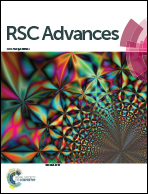A new strategy for hydrogen storage using BNNS: simultaneous effects of doping and charge modulation
Abstract
The adsorption behavior of hydrogen molecule (H2) on neutral and charged states of C-, Si- and P-doped boron nitride nanosheets (BNNSs), is investigated using density functional theory (DFT) method. The obtained results show that while neutral states and charged states of Si- and P-doped BNNSs adsorb H2 weakly, the negatively charged states of CB-BNNS, in which B atom of the nanosheet is replaced by C atom, increase prominently adsorption energy such that four hydrogen molecules per dopant can be effectively trapped (Eads > 0.2 eV/H2). This superiority, which supported by the flatness of the surface, more chemical reactivity and thermodynamic stability turn CB-BNNS into a promising candidate for H2 adsorption. More importantly, the hydrogen storage/release processes on CB-BNNS can be simply controlled by switching on/off the charging voltage. This behavior is mainly supported by drastic variation of dipole moment of adsorbent and adsorbate as well as HOMO–LUMO energy gap (Egap) of CB-BNNS upon charging. The results also reveal that the induction forces play the main role in the hydrogen adsorption. Finally, the atoms in molecules (AIM) methodology shows that, in uncharged systems, interaction of H2 with C dopant, due to more the covalent character, is more effective than those of Si and P. Further, the fact that the charge injection leads to a stronger interaction, while the charge removal reflects an inverse trend, agrees with the Eads variations.


 Please wait while we load your content...
Please wait while we load your content...